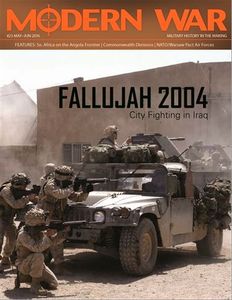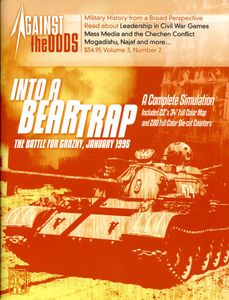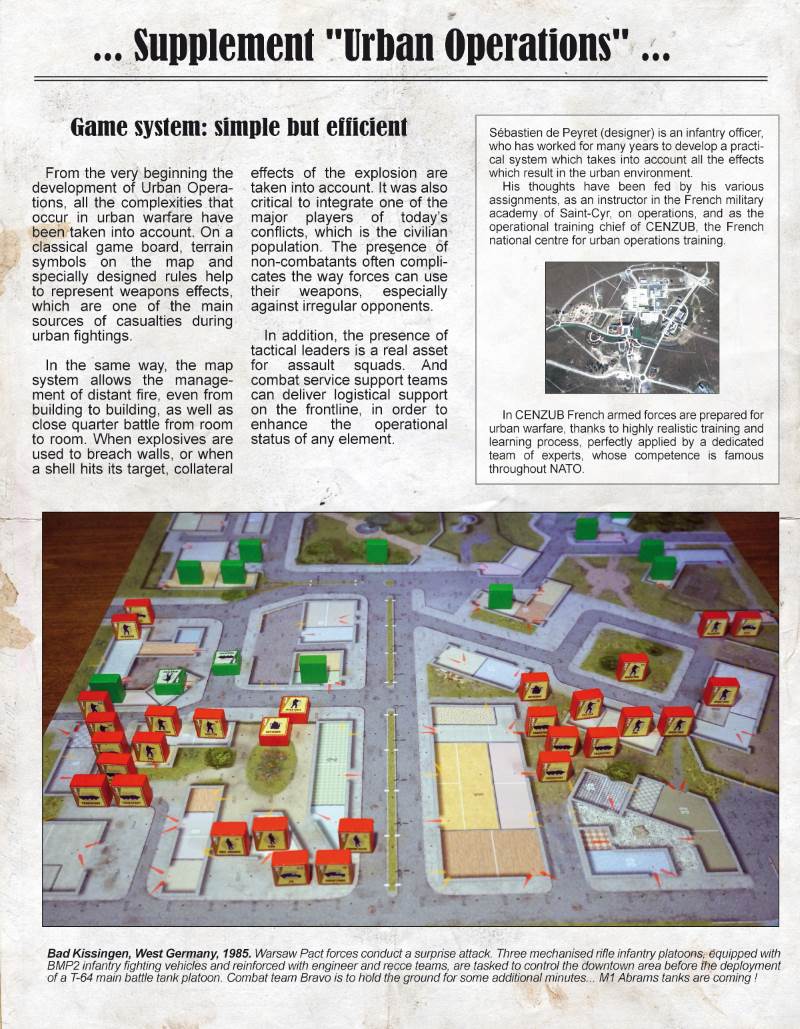|
|
 |
 |
|
|
|
Guerra urbana moderna
PROVA SUL CAMPO
Prova sul campo rappresenta “la voce” dei soci A.S.G.S. in merito a vecchie e nuove simulazioni che il mercato dei board-wargames offre. Una serie di pagine dove poter trovare piccole recensioni e/o resoconti di partite sui board-wargames che vengono giocati dal gruppo. Siamo sempre alla ricerca anche di collaboratori; se volete inviare articoli su giochi che amate e conoscete, contattate l’Amministratore.

Un interessante sito con recensioni: http://www.armchairgeneral.com/category/boardgame-reviews
Da Wikipedia:
La guerra urbana è la guerra moderna condotta in aree urbane quali città e metropoli. Convenzionalmente, le operazioni belliche condotte in centri abitati prima del XX secolo sono considerate guerra d’assedio.
La guerra urbana è assai diversa dal combattimento in campo aperto sia sul piano operativo sia sul piano tattico. Sono peculiari elementi di complicazione la presenza di civili e quella di edifici di ogni sorta.
Talora è difficile distinguere i civili da combattenti quali gli appartenenti a milizie armate o a gang, in particolar modo quando si tratti di soggetti che tentano “semplicemente” di difendere le proprie case dagli attaccanti.[1] La tattica è complicata dalla spiccata tridimensionalità dell'”arena”, dal limitato campo visivo (che si riflette, naturalmente, in modo analogo sulle direttrici di tiro) a causa di edifici, strutture innalzate dai difensori per occultarsi, varie opere (urbanistiche e/o di “sottoservizi”)[2] preesistenti al suolo, per non parlare della facilità con cui gli “assediati” possono ricorrere a trappolamenti[3][4] ed a franchi tiratori.
Negli Stati Uniti sono comuni le abbreviazioni UO per Urban Operations e MOUT per Military Operations in Urban Terrain.[5] Nel Regno Unito si usano: OBUA (Operations in Built-Up Areas)[6] o FIBUA (Fighting in Built-Up Areas)[7] o a volte FISH (Fighting In Someone’s House).[8][9] Il termine FOFO (Fighting in Fortified Objectives)[10] si riferisce alla “bonifica” dalla presenza ostile di posti angusti e trincerati quali bunker, trinceeed altre fortificazioni; l’eliminazione di mine e cavi; il consolidamento delle teste di ponte in campo avverso.[11]
Esempio classico della guerra urbana sono i combattimenti nella città di Stalingrado che si prolungarono con alterne vicende per oltre due mesi nell’area cittadina di Stalingrado durante la seconda guerra mondialetra ingenti forze della Wehrmacht tedesca e dell’Armata Rossa sovietica. I soldati tedeschi denominarono Rattenkrieg (“guerra dei topi”) la guerra urbana nelle rovine di Stalingrado. Altre cruente e durissime battaglie urbane durante il secondo conflitto mondiale furono la battaglia di Budapest e la battaglia di Berlino.
Combattimenti urbani moderni
 |
 |
 |
-250x250.jpg) |
IntroduzioneNegli ultimi anni ha assunto particolare importanza, nel programmare la preparazione degli eserciti moderni, il combattimento negli agglomerati urbani. Argomento poco trattato a livello di boardwargames, anche se in realtà molto interessante e con dinamiche che possono aiutare a comprendere gli eventi che ormai sono all’ordine del giorno nella nostra vita e spesso e volentieri, purtroppo, legati ad episodi di terrorismo internazionale. Di seguito, quindi, alcuni titoli nella mia collezione ed in attesa di pubblicazione che ritengo molto interessanti.
|
|||||
|
BEIRUT ’82: ARAB STALINGRAD, è il titolo del gioco contenuto nel numero 126 del 1989 della celeberrima rivista Strategy & Tactics, http://strategyandtacticsmagazine.com/site/ La rivista, all’epoca, era meno “corposa” delle attuali ma sempre interessante. Gli articoli di questo numero erano dedicati all’operazione Iron Brain, cioè l’assalto a Beirut durante le operazioni di “Pace in Galilea” del 1982, ai conflitti a bassa intensità come li si considerava in quegli anni e altri su vari argomenti. Il gioco tratta dell’attacco organizzato nel giungo 1982 da parte della IDF (israeli defence force) contro l’OLP, cioè l’organizzazione di Arafat. La battaglia ebbe grossi coinvolgimenti politici e le regole di gioco ne tengono conto in vario modo; L’autore, Thomas Kane, non a caso era un appassionato di Diplomacy, https://boardgamegeek.com/boardgame/483/diplomacy…………….. Pochissime le pedine necessarie al gioco, rappresentati corazzati, fanteria ed artiglierie a livello di brigate. La mappa è molto piccola ma molto colorata, completa di tabelle e una mappa geografica che permette di capire dove si svolse la battaglia.
IN TO THE BEAR TRAP: THE BATTLE FOR GROZNY, JANUARY 1995, ricrea l’attacco sferrato dall’esercito russo alla città di Grozny. Il piano di attacco prevedeva un massiccio sforzo dell’esercito e dell’aviazione atto ad intimidire la popolazione come già era avvenuto nel 1991. Colonne di taks, artiglieria dispiegata in numerose batterie e gli aerei furono quindi lanciati contro le forze ribelli cecene. Da parte loro i ceceni disponevano di ottime armi RPG, mortai e diversi cecchini con le quali erano pronti a contrastare nelle vie della città, metro per metro, l’esercito russo. Il gioco è contenuto nel Volume 3, numero 2 del 2004 di Against the Odds, https://boardgamegeek.com/boardgamepublisher/1244/against-odds Ottima rivista anche questa, purtroppo non più disponibile. La rivista contiene numerosi articoli, in questo caso dedicati sia alla battaglia di Grozny, anche dal punto di vista dell’influenza operata dai mass media, sia ad altri interessanti argomenti quali modelli di combattimento e relative tabelle “CRT”, scritto da John Prados, e un approfondito articolo sui leaders della guerra civile americana e alcune simulazioni, fra cui anche la serie Great Battles of American Civil War, che trattano l’utilizzo di tali comandanti sul campo. Un foglio di pedine, non molto belle, rappresentano le parti in campo nella battaglia del 1995 in Cecenia. Una mappa, altrettanto poco bella, raffigura gran parte della città di Grozny; una griglia esagonale regola i movimenti.
Su BGG ho trovato questa interessante recensione di Arrigo Velicogna, https://boardgamegeek.com/user/Mad%20Archeologist:
FALLUJAH 2004: CITY FIGHTING IN IRAQ, Modern War #23, May-June 2016 https://shop.strategyandtacticspress.com/SearchResults.asp?Cat=35, is a solitaire wargame system covering the Coalition fight to retake the city of Fallujah from Iraqi insurgents in 2004. This led to two battles, the first in April and the second in November. These became some of the biggest engagements of the Gulf War. The player controls Coalition forces while the game system controls the Opposition forces (the Insurgents), known in the game as OPFOR. This game includes scenarios for both battles for Fallujah, as well as a scenario allowing you to fight the entire campaign. Discover brand new game mechanisms for tactical Modern Warfare! Urban Operations uses blocks to simulate the Fog of War, and blocks rotation to show units hits. 3 campaigns (16 scenarios) including some famous fights:
Game system: simple but efficient. From the very beginning the development of Urban Operations, all the complexities that occur in urban warfare have been taken into account. On a classical game board, terrain symbols on the map and specially designed rules help to represent weapons effects, which are one of the main sources of casualties during urban fightings. In the same way, the map system allows the management of distant fire, even from building to building, as well as close quarter battle from room to room. When explosives are used to breach walls, or when a shell hits its target, collateral effects of the explosion are taken into account. It was also critical to integrate one of the major players of today’s conflicts, which is the civilian population. The presence of non-combatants often complicates the way forces can use their weapons, especially against irregular opponents. In addition, the presence of tactical leaders is a real asset for assault squads. And combat service support teams can deliver logistical support on the frontline, in order to enhance the operational status of any element. Components: • Boxed game, • 5 maps: Four 72cm x 54cm and one 72cm x 13cm, • Two 24cm x 30cm game map (underground), • 199 die-cut counters, • One 82 et one 74 stickers sheet, • 160 wooden blocks, • Rules booklet, • 3 Campaign rules booklet, • 16 scenario player aids, • 2 player aids in english, • 1 set of 144 playing cards, • 2 dices
URBAN OPERATIONS, della NUTS Publishing, è tutt’ora in preordine sul web della ditta Nuts, ma sembra veramente un ottimo prodotto. Sono già previsti vari moduli dedicati a varie situazioni e ambienti urbani, vedi http://www.nutspublishing.com/Urban-Operations Disponibili anche le regole in lingua inglese: https://boardgamegeek.com/file/download/skvlswe4em/Rules_UrbanOperations_V1.pdf
Altri titoli interessanti: https://boardgamegeek.com/boardgame/29848/battle-baghdad
|
|||||
|
Gian Carlo Ceccoli |
IL LIBRO DEL MESE
GUERRA NELLE CITTA’
Andrea Lopreiato

Le città, in particolare le grandi metropoli costiere, saranno i teatri di guerra dei prossimi conflitti ma, nonostante le previsioni degli esperti, all’interno delle Forze Armate dei Paesi occidentali stenta a decollare la costituzione di unità dedicate a questa specifica forma di combattimento. Questo saggio ricostruisce settant’anni di guerre nelle città, dalle guerre arabo-israeliane del 1948, alle sanguinose battaglie nelle città vietnamite del 1968, alla missione in Somalia, fino ai recenti scontri nella Striscia di Gaza, e dall’analisi tattico-militare trae preziose considerazioni sulle guerre che gli eserciti regolari dovranno affrontare e sulle lacune che andrebbero colmate in termini di addestramento, risorse umane, mezzi, materiali e intelligence.
Le battaglie analizzate sono le seguenti: Gerusalemme nel 1967, Suez nel 1973, Beirut 1982, Saigon 1968, Huè 1968, Sarajevo 1992-1995, Mogadiscio 1993, Grozny 1994-2000, Fallujah 2004, Gaza. Ognina viene analizzata dal punto di vista geografico e del terreno, le forze in campo e lo svolgimento della battaglia. Un libro che rappresenta un must per gli esperti di settore e anche per gli appassionati di boardwargames!





